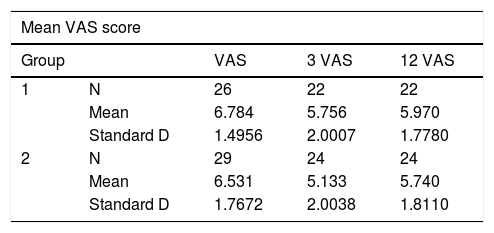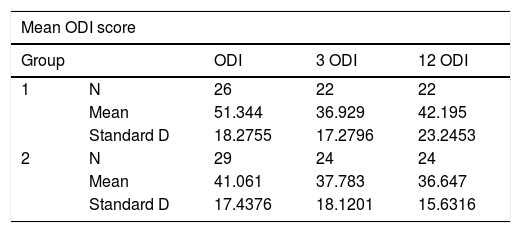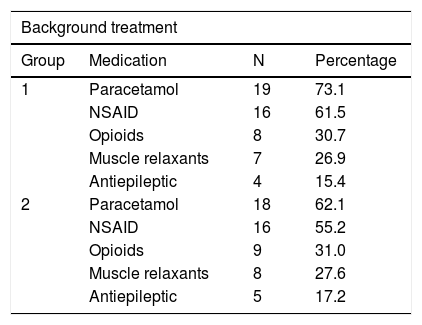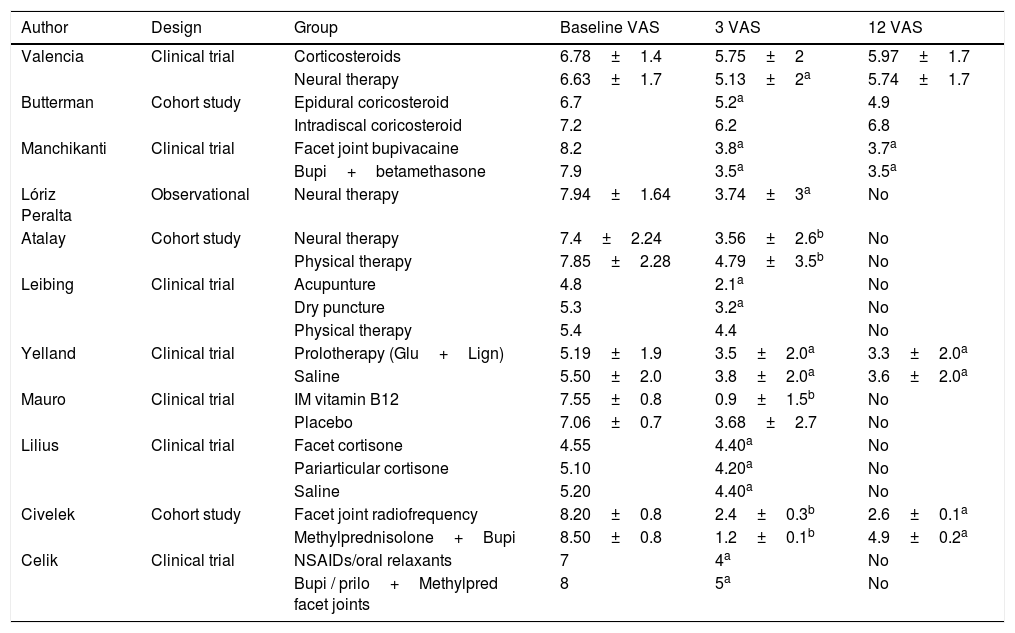Local infiltrations are second line therapy in the treatment of chronic low back pain, although their use is controversial in the literature. Our objective was to compare the effectiveness of 2 types of infiltration at the paravertebral lumbar level in two groups of patients diagnosed with low back pain: corticosteroids, and selective local anaesthetic administered using segmental neural therapy (SNT).
Material and MethodsDouble-blind clinical trial in 55 patients diagnosed with low back pain in the neurosurgery department of the Hospital Central de la Defensa Gómez Ulla. Patients were randomised to 2 treatment groups to receive either paravertebral injections of corticosteroids or SNT. Outcomes were measured using a visual analogue scale (VAS), the Oswestry Disability Index (ODI), the Short Form-36, and patient satisfaction at the start of treatment (baseline) and at 3 and 12 months post intervention.
ResultsThe combined treatment group showed a statistically significant improvement in ODI at 3 months. The SNT group showed a statistically significant improvement in baseline VAS vs. VAS at 3 (1.398cm, p=0.001) and 12 months (0.791cm, p=0.007). No differences were observed in the remaining variables measured. The percentage of patients that would repeat the treatment was 81% and 83%, respectively.
ConclusionsSignificant pain relief was achieved with SNT, and disability improved with the combined treatment. Although clinical improvement was limited, patients were satisfied. Local infiltrations should be considered as an alternative treatment for chronic low back pain.
Clinical Trial RegistrationThis clinical trial was registered at the European Union Clinical Trials Register with EUDRA-CT number 2015-001146-29.
Las infiltraciones locales son utilizadas como segunda línea en el tratamiento del dolor lumbar crónico aunque constituyen una alternativa terapéutica controvertida en la literatura. El objetivo de este ensayo clínico fue comparar la efectividad de dos tipos de infiltraciones locales: infiltración paravertebral lumbar con corticoides y anestesia local selectiva, mediante la técnica de Terapia Neural Segmentaria (TNS); en dos grupos de pacientes diagnosticados de dolor lumbar.
Material y MétodosSe realizó un ensayo clínico a doble ciego con 55 pacientes diagnosticados de dolor lumbar en el Hospital Central de la Defensa Gómez Ulla. Los pacientes fueron aleatorizados en dos grupos de tratamiento Se realizó infiltración paravertebral con corticoides y TNS en cada grupo. Registrándose la puntuación en la Escala Visual Analógica (EVA), el Oswestry Disability Index (ODI), Short Form-36 y la satisfacción, al inicio, y a los 3 y 12 meses posteriores a la intervención.
ResultadosEl grupo de tratamiento combinado obtuvo una mejoría estadísticamente significativa para el ODI a los 3 meses. El grupo de TNS obtuvo una mejora estadísticamente significativa al comparar EVA inicial con la EVA a los 3 meses (1.398cm, p=0.001) y a los 12 meses (0.791cm, p=0.007). No se observaron diferencias en el resto de las variables evaluadas. El porcentaje de pacientes que repetirían el tratamiento fue de 81% y 83% respectivamente.
ConclusiónSe obtuvieron resultados significativos para el alivio del dolor con TNS y la discapacidad con el tratamiento combinado. Aunque la mejoría clínica fue limitada, los pacientes estaban satisfechos. Las infiltraciones locales deben considerarse como un tratamiento alternativo para el dolor lumbar crónico.
Registro de ensayos clínicosEste ensayo clínico se registró en el registro de ensayos clínicos de la Unión Europea con el número EUDRA-CT 2015-001146-29.
Artículo
Comprando el artículo el PDF del mismo podrá ser descargado
Precio 19,34 €
Comprar ahora











